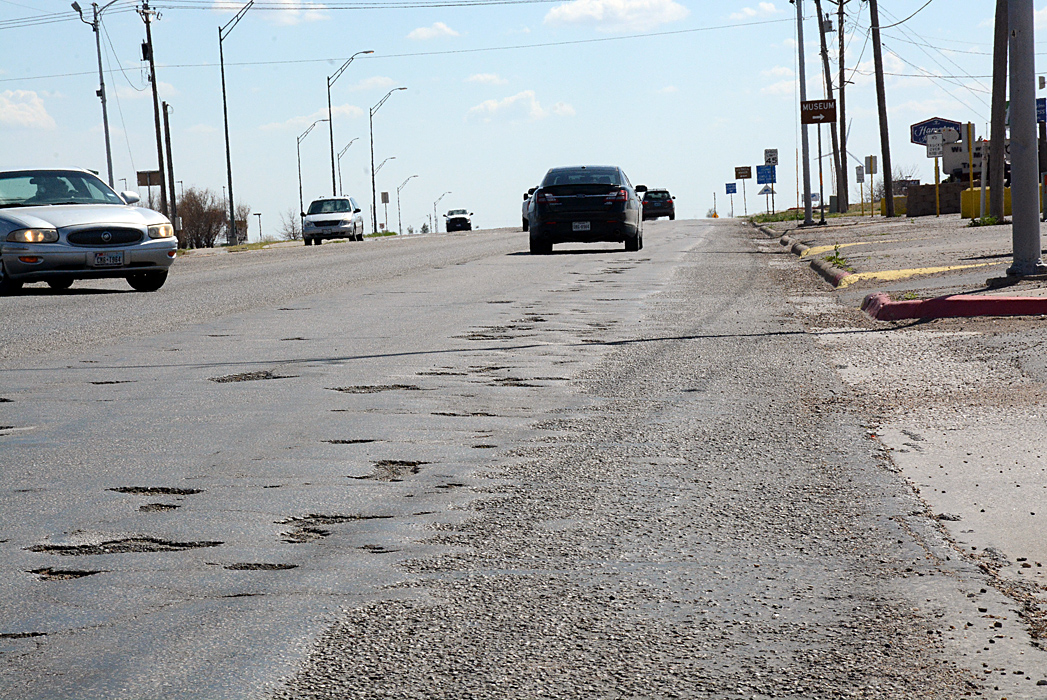Last Updated on March 21, 2016 – 11:49 AM CDT
Above: After years of damage from an extreme drought and then a sudden abundance of moisture, Dumas Avenue’s structural failure produced potholes that continue to grow in size and number. TxDOT said they’ll begin repairs within the month.
Help is on the way for a road that looks like it has been bombed. TxDOT says work on Dumas Avenue from 14th Street south to near Walmart should begin in a couple of weeks, repairing a stretch of road cratered with potholes that have multiplied and grown larger during the past months.
TxDOT Public Information Officer Paul Braun said the southbound right lane will be milled and repaved “to try and hold that area until a more extensive reconstruction can be done.” Dumas Avenue is a TxDOT road, which makes them responsible for its maintenance, not the city of Dumas. Given that TxDOT’s road becomes Dumas Avenue, the city’s main street, the state says they want to work with the city to maintain TxDOT’s roads in the city limits.
“TxDOT has been and continues to work with the city of Dumas and Moore County on plans to improve safety and mobility on U.S. 287/87 and other roadways in the area,” Braun said. “A reconstruction project on U.S. 287/87 is scheduled, and the process has begun to conduct soil and pavement tests in anticipation of that project. In the short term, TxDOT maintenance crews will do what work they can to patch problem areas on the roadway until the reconstruction project can be done.”
That reconstruction project is one that would replace the asphalt on Dumas Avenue with concrete, and TxDOT has it on their 2018 calendar. While the proposed relief route south of Dumas doesn’t necessarily complicate the Dumas Avenue reconstruction project, it does affect it. In a recent meeting between Dumas and TxDOT officials, Gus Khankarli, TxDOT director of transportation, planning and development, said relieving Dumas Avenue of the heavy truck traffic will determine how the reconstruction project is designed. It’s possible, he said, that asphalt could continue to be used on the road if studies determine it can handle the traffic. If it can’t, then concrete it is.
Still, while TxDOT pursues and studies reconstruction plans, drivers swerve to miss potholes that are really the weather’s fault and not TxDOT’s. The roads suffered from the damaging effects of several years of an extreme drought that evaporated the moisture in the base and substructure. The roads cracked, and then groaned from the contractions and expansions caused by hot and cold weather extremes. The pavement opened, exposing it to the elements. Then the drought suddenly ended, and it rained. A lot.
“When we have excessive moisture like we experienced in 2015 (30 inches), that moisture gets in the cracks and settles into the dried-out base and substructure,” Braun said. “This causes the roadway base to have uneven amounts of moisture and dryness underneath the pavement and causes the pavement to break up. Heavy traffic causes that moisture to penetrate even deeper, making for even larger areas of pavement failure.”
And potholes are born.
TxDOT had planned to do maintenance on Dumas Avenue last year while working on Highway 152. But the advanced deterioration of that road made it unsafe, so TxDOT concentrated its efforts on repairing it. Someone driving 75 mph on a highway has a higher risk of losing control when hitting a pothole than someone driving 35 mph and hitting one on Dumas Avenue, Braun said.
“Safety is the top priority of TxDOT and the basis for planning, building and maintaining our transportation systems,” Braun said.
So while TxDOT’s maintenance crews gear up to mill and repave parts of the south end of Dumas Avenue, talks and studies have begun for a relief route that will affect Dumas Avenue’s future.
“We are working on a plan showing the main activities needed before any engineering work is undertaken for both the in-town section and proposed relief route,” Braun said.
